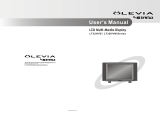
4
important information About Your TV
Installation Notes
Stand Requirement
CAUTION: Use these Mitsubishi TV models only with the
Mitsubishi stand models shown here. Other stands can
result in instability and possibly cause injury.
WD-60C8, WD-60735,
WD-65C8, WD-65735, MB-$60/65
WD-65736
WD-73C8, WD-73735
MB-S73
WD-73736
835 Series Stands: Mitsubishi does not design, manufac-
ture or sell matching bases for 835 series model televisions
(WD-65835, WD-73835). When selecting a stand, base
or other furniture to support the TV, please make sure it is
designed with the appropriate dimensions for stability and to
support the TV's total weight as well as the weight of any addi-
tional equipment you plan to store.
Custom cabinet installation must allow for proper air
circulation around the television.
NOTE TO CATVSYSTEM iNSTALLER: THIS REMINDERIS
PROVIDEDTOCALL THE CATVSYSTEM INSTALLER'SATTEN-
TIONTOARTICLE 820-40 OFTHE NECTHATPROVIDESGUIDE-
LINES FORTHE PROPERGROUNDINGAND, IN PARTICULAR,
SPECIFIESTHATTHE CABLE GROUND SHALL BE CONNECTED
TOTHE GROUNDING SYSTEMOFTHE BUILDING, AS CLOSE
TOTHE POINTOF CABLE ENTRYAS PRACTICAL.
Internal Fans
Internal cooling fans maintain proper operating tempera-
tures inside the TV. It is normal to hear the fans when you
first turn on the TV, during quiet scenes while viewing the
TV, and for a short time after shutting off the TV. You may
notice louder fan noise about 30 seconds after shutting off
the TV and while using the Bright Lamp Mode.
Lamp Replacement
For lamp-replacement instructions, see Appendix D.
To Order a Replacement Lamp Under Warranty
Call (800) 553-7278. Please have model number, serial
number, and TV purchase date available.
important: All lamps replaced under warranty must
be returned to Mitsubishi where they will be inspected
for defect verification.
To Purchase a Replacement Lamp After Warranty
Visit our website at www.mitsuparts.com or call
(800) 553-7278. Order new lamp part number
915B403001.
TV Software
Do not attempt to update the software of thisTV with software
or USBdrives not provided by or authorized by Mitsubishi Digital
Electronics America, Inc. Non-authorized software may damage
the TV and will not be covered by the warranty.
Cleaning Recommendations
Normally, light dusting with a dry, non-scratching duster
will keep your TV clean. If cleaning beyond this is needed,
please use the following guidelines:
First, turn off the TV and unplug the power cord from the
power outlet.
Occasionally clean dust build-up from the air-intake grilles
on the back and sides of the TV. Clean using a vacuum
cleaner with a brush attachment.
Top and Sides of the TV
• Gently wipe down your TV with a soft, non-abrasive
cloth such as cotton flannel or a clean cloth diaper,
lightly moistened with water. Dry with a second dry,
soft, non-abrasive cloth.
For oily dirt, add a few drops of mild liquid detergent,
such as dishwashing detergent, to the water used to
moisten the cloth. Rinse with a second cloth moist-
ened only with water. Dry with a third dry, soft, non-
abrasive cloth.
Glossy Surfaces {835 series models}
Use the soft cleaning cloth supplied with the TV.
Clean the cloth before each use by shaking or brush-
ing to remove any residual dirt particles.
Gently wipe down the glossy surfaces of your TV with
the soft cloth. Do not apply pressure while wiping.
If necessary, lightly dampen the soft cloth with water.
Do not use chemical or abrasive cleaners.
Wash the soft cloth by hand or machine. Use only
mild soap.
Screen
Follow the instructions for the top and sides, wiping
gently in an up and down motion.
Clean the entire screen evenly, not just sections of the
screen.
Do not allow liquid to drip down the screen, as some
liquid may enter the TV through the gap between the
screen and screen frame.
You may purchase Mitsubishi Screen Cleaner, part
number CLEANER-VSS, by calling (800) 553-7278.
General Cleaning Precautions
= DO NOT allow liquid to enter the TV through the venti-
lation slots or any crevice.
• DO NOT use any strong or abrasive cleaners, as
these can scratch the surfaces.
DO NOT use any cleaners containing ammonia,
bleach, alcohol, benzene, or thinners, as these can
dull the surfaces.
DO NOT spray liquids or cleaners directly on the TV's
surfaces.
DO NOT scrub or rub the TV harshly. Wipe it gently.






















